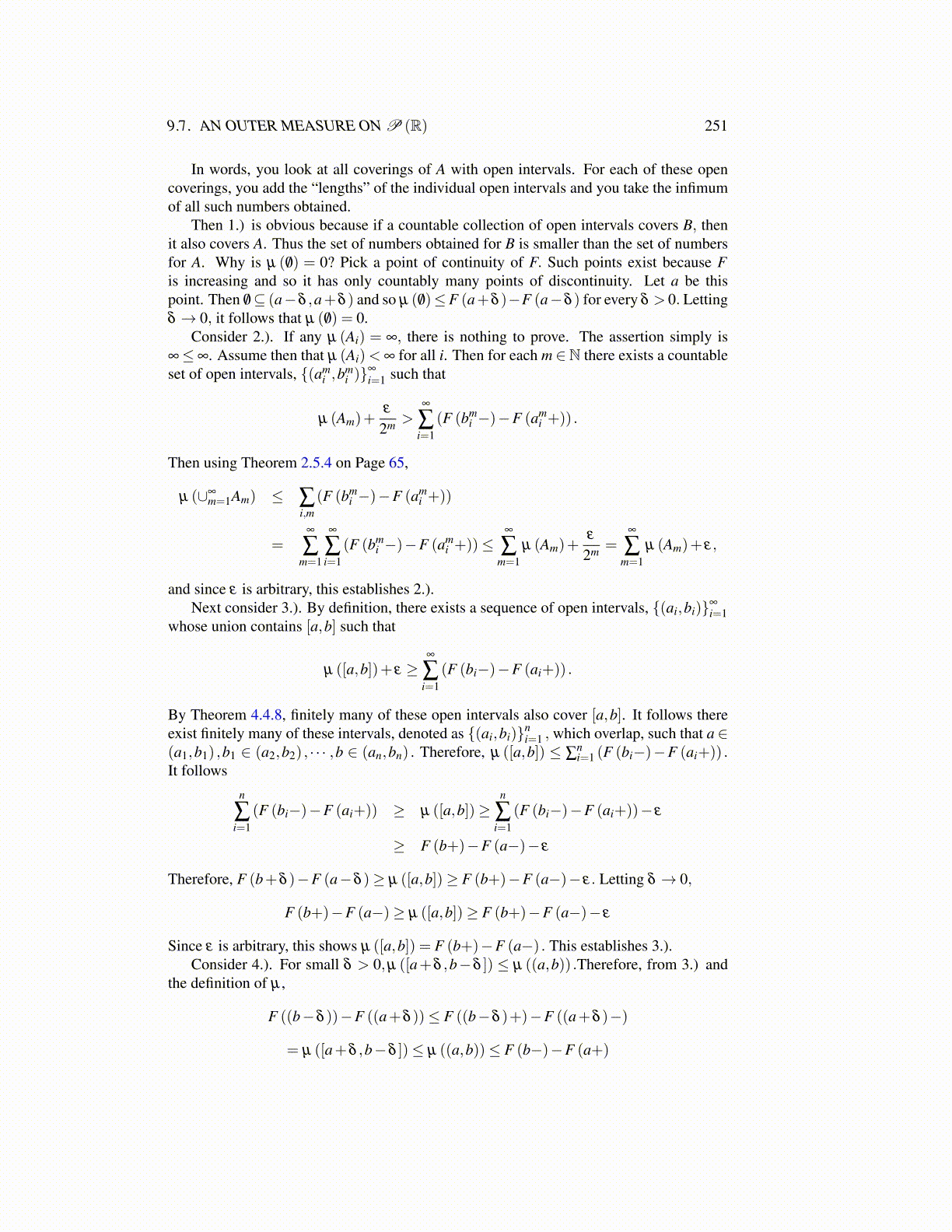
9.7. AN OUTER MEASURE ON P (R) 251
In words, you look at all coverings of A with open intervals. For each of these opencoverings, you add the “lengths” of the individual open intervals and you take the infimumof all such numbers obtained.
Then 1.) is obvious because if a countable collection of open intervals covers B, thenit also covers A. Thus the set of numbers obtained for B is smaller than the set of numbersfor A. Why is µ ( /0) = 0? Pick a point of continuity of F. Such points exist because Fis increasing and so it has only countably many points of discontinuity. Let a be thispoint. Then /0⊆ (a−δ ,a+δ ) and so µ ( /0)≤F (a+δ )−F (a−δ ) for every δ > 0. Lettingδ → 0, it follows that µ ( /0) = 0.
Consider 2.). If any µ (Ai) = ∞, there is nothing to prove. The assertion simply is∞≤∞. Assume then that µ (Ai)< ∞ for all i. Then for each m ∈N there exists a countableset of open intervals, {(am
i ,bmi )}
∞
i=1 such that
µ (Am)+ε
2m >∞
∑i=1
(F (bmi −)−F (am
i +)) .
Then using Theorem 2.5.4 on Page 65,
µ (∪∞m=1Am) ≤ ∑
i,m(F (bm
i −)−F (ami +))
=∞
∑m=1
∞
∑i=1
(F (bmi −)−F (am
i +))≤∞
∑m=1
µ (Am)+ε
2m =∞
∑m=1
µ (Am)+ ε,
and since ε is arbitrary, this establishes 2.).Next consider 3.). By definition, there exists a sequence of open intervals, {(ai,bi)}∞
i=1whose union contains [a,b] such that
µ ([a,b])+ ε ≥∞
∑i=1
(F (bi−)−F (ai+)) .
By Theorem 4.4.8, finitely many of these open intervals also cover [a,b]. It follows thereexist finitely many of these intervals, denoted as {(ai,bi)}n
i=1 , which overlap, such that a ∈(a1,b1) ,b1 ∈ (a2,b2) , · · · ,b ∈ (an,bn) . Therefore, µ ([a,b]) ≤ ∑
ni=1 (F (bi−)−F (ai+)) .
It followsn
∑i=1
(F (bi−)−F (ai+)) ≥ µ ([a,b])≥n
∑i=1
(F (bi−)−F (ai+))− ε
≥ F (b+)−F (a−)− ε
Therefore, F (b+δ )−F (a−δ )≥ µ ([a,b])≥ F (b+)−F (a−)− ε. Letting δ → 0,
F (b+)−F (a−)≥ µ ([a,b])≥ F (b+)−F (a−)− ε
Since ε is arbitrary, this shows µ ([a,b]) = F (b+)−F (a−) . This establishes 3.).Consider 4.). For small δ > 0,µ ([a+δ ,b−δ ]) ≤ µ ((a,b)) .Therefore, from 3.) and
the definition of µ ,
F ((b−δ ))−F ((a+δ ))≤ F ((b−δ )+)−F ((a+δ )−)
= µ ([a+δ ,b−δ ])≤ µ ((a,b))≤ F (b−)−F (a+)